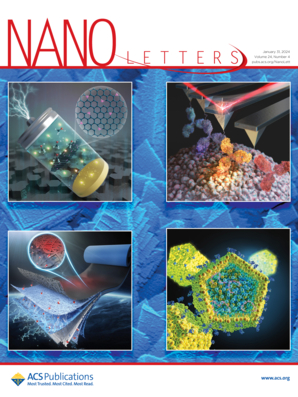Andreev Reflection in the Quantum Hall Regime at an Al/InAs Junction on a Cleaved Edge
IF 9.1
1区 材料科学
Q1 CHEMISTRY, MULTIDISCIPLINARY
引用次数: 0
Abstract
We have fabricated a superconductor/semiconductor junction composed of Al and InAs using cleaved edge overgrowth. By exploiting the unique geometry with a thin Al/Pt/Al trilayer formed on the side surface of an in situ cleaved InAs quantum well heterostructure wafer, we achieve a superconducting critical field of ∼5 T, allowing superconductivity and quantum Hall (QH) effects to coexist down to filling factor ν = 3. Andreev reflection at zero magnetic field shows a conductance enhancement limited solely by the Fermi velocity mismatch, demonstrating a virtually barrier-free junction. Bias spectroscopy in the QH regime reveals the opening of a superconducting gap, with the reduced downstream resistance indicating electron–hole Andreev conversion. Our results, obtained in a new experimental regime characterized by a clean edge-contacted junction with a superconducting electrode narrower than the coherence length, open new avenues for both theoretical and experimental studies of the interplay between superconductivity and QH effects.

劈边 Al/InAs 结的量子霍尔效应中的安德烈耶夫反射
我们利用裂边过度生长技术制造了一个由铝和砷化镓组成的超导体/半导体结。通过利用在原位切割的 InAs 量子阱异质结构晶片侧表面形成的薄 Al/Pt/Al 三层的独特几何形状,我们实现了 ∼5 T 的超导临界磁场,使超导和量子霍尔(QH)效应在填充因子 ν = 3 时得以共存。零磁场下的安德烈耶夫反射显示,电导增强仅受费米速度失配的限制,这证明了结点实际上是无势垒的。QH 状态下的偏压光谱显示超导间隙打开,下游电阻减小,表明电子-空穴安德列夫转换。我们的研究结果是在一种新的实验机制下获得的,这种机制的特点是具有比相干长度更窄的超导电极的清洁边缘接触结,这为超导和 QH 效应之间相互作用的理论和实验研究开辟了新的途径。
本文章由计算机程序翻译,如有差异,请以英文原文为准。
求助全文
约1分钟内获得全文
求助全文
来源期刊

Nano Letters
工程技术-材料科学:综合
CiteScore
16.80
自引率
2.80%
发文量
1182
审稿时长
1.4 months
期刊介绍:
Nano Letters serves as a dynamic platform for promptly disseminating original results in fundamental, applied, and emerging research across all facets of nanoscience and nanotechnology. A pivotal criterion for inclusion within Nano Letters is the convergence of at least two different areas or disciplines, ensuring a rich interdisciplinary scope. The journal is dedicated to fostering exploration in diverse areas, including:
- Experimental and theoretical findings on physical, chemical, and biological phenomena at the nanoscale
- Synthesis, characterization, and processing of organic, inorganic, polymer, and hybrid nanomaterials through physical, chemical, and biological methodologies
- Modeling and simulation of synthetic, assembly, and interaction processes
- Realization of integrated nanostructures and nano-engineered devices exhibiting advanced performance
- Applications of nanoscale materials in living and environmental systems
Nano Letters is committed to advancing and showcasing groundbreaking research that intersects various domains, fostering innovation and collaboration in the ever-evolving field of nanoscience and nanotechnology.
 求助内容:
求助内容: 应助结果提醒方式:
应助结果提醒方式:


